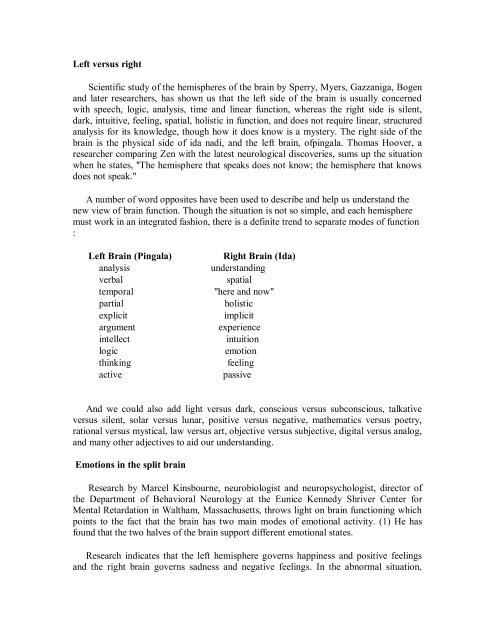Kundalini.Tantra.by.Satyananda.Saraswati
You also want an ePaper? Increase the reach of your titles
YUMPU automatically turns print PDFs into web optimized ePapers that Google loves.
Left versus right<br />
Scientific study of the hemispheres of the brain <strong>by</strong> Sperry, Myers, Gazzaniga, Bogen<br />
and later researchers, has shown us that the left side of the brain is usually concerned<br />
with speech, logic, analysis, time and linear function, whereas the right side is silent,<br />
dark, intuitive, feeling, spatial, holistic in function, and does not require linear, structured<br />
analysis for its knowledge, though how it does know is a mystery. The right side of the<br />
brain is the physical side of ida nadi, and the left brain, ofpingala. Thomas Hoover, a<br />
researcher comparing Zen with the latest neurological discoveries, sums up the situation<br />
when he states, ''The hemisphere that speaks does not know; the hemisphere that knows<br />
does not speak."<br />
A number of word opposites have been used to describe and help us understand the<br />
new view of brain function. Though the situation is not so simple, and each hemisphere<br />
must work in an integrated fashion, there is a definite trend to separate modes of function<br />
:<br />
Left Brain (Pingala)<br />
Right Brain (Ida)<br />
analysis<br />
understanding<br />
verbal<br />
spatial<br />
temporal<br />
"here and now"<br />
partial holistic<br />
explicit implicit<br />
argument experience<br />
intellect intuition<br />
logic emotion<br />
thinking feeling<br />
active passive<br />
And we could also add light versus dark, conscious versus subconscious, talkative<br />
versus silent, solar versus lunar, positive versus negative, mathematics versus poetry,<br />
rational versus mystical, law versus art, objective versus subjective, digital versus analog,<br />
and many other adjectives to aid our understanding.<br />
Emotions in the split brain<br />
Research <strong>by</strong> Marcel Kinsbourne, neurobiologist and neuropsychologist, director of<br />
the Department of Behavioral Neurology at the Eunice Kennedy Shriver Center for<br />
Mental Retardation in Waltham, Massachusetts, throws light on brain functioning which<br />
points to the fact that the brain has two main modes of emotional activity. (1) He has<br />
found that the two halves of the brain support different emotional states.<br />
Research indicates that the left hemisphere governs happiness and positive feelings<br />
and the right brain governs sadness and negative feelings. In the abnormal situation,














![[Lonely Planet] Sri Lanka](https://img.yumpu.com/59845622/1/169x260/lonely-planet-sri-lanka.jpg?quality=85)


